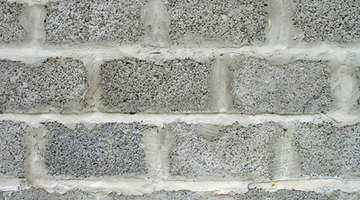How to Waterproof Cinder Block Basement Walls
Your cinder-block basement wall must be waterproofed to provide a proper home environment; otherwise, water will seep in through the walls of your basement. This water can cause structural damage and grow mold. By waterproofing your basement, you will be preventing health dangers and also costly repairs.

Waterproofing can be done easily before it is too late. Following the proper steps will ensure a correct waterproofing of your basement cinder-block wall.
Things You Will Need
- Hydraulic cement
- Wire brush
- Sundry paint or DryLok
- Masonry paint brush
- Thick-nap roller
Tip
If walls are damp but not wet, you can still apply waterproofing paint. Touch the wall with bare fingers to determine how wet it is; if your fingers come away dry, then it is okay to paint.
Warning
Use a respirator when working with waterproofing paint and work in a well-ventilated area. Because basements are often difficult to vent, use one or two large fans to create a crosswind.
-
Prepare the surface by removing any dirt, loose mortar or efflorescence (white powdery substance). If there is currently oil-based paint on the walls, it must also be removed.
-
Patch any holes in the basement cinder-block wall with your hydraulic cement. Push the cement into the cracks and crevices, making sure to pack and seal. The cement becomes hard quickly, so be time-efficient. Allow the cement to dry before proceeding (usually 24 hours).
-
Use a masonry paint brush to apply the first coat of Sundry or DryLok paint to the cinder-block walls. Using your masonry brush, dip into the paint and stroke in any direction on the wall, covering the wall completely with paint, including all crevices in the block. This paint will go on much thicker than standard wall paint. Allow the first coat to dry 12 hours.
-
Cover the wall with a second and even third coat of paint to ensure a good layer of water protection in your basement. You can use a thick-nap roller to apply second or third coats. Make sure to keep applying layers of paint until you no longer see the pigment in the brick and there is a thick layer of paint on the brick.
The Drip Cap
- Your cinder-block basement wall must be waterproofed to provide a proper home environment; otherwise, water will seep in through the walls of your basement.
- Use a masonry paint brush to apply the first coat of Sundry or DryLok paint to the cinder-block walls.
- Cover the wall with a second and even third coat of paint to ensure a good layer of water protection in your basement.
- You can use a thick-nap roller to apply second or third coats.
Resources
Photo Credits
- block wall image by Irina Kodentseva from Fotolia.com
- block wall image by Irina Kodentseva from Fotolia.com
More Articles


